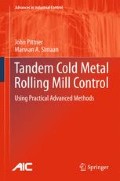Abstract
This chapter presents an overall view of conventional control concepts for the tandem cold metal rolling process to serve as a background for the chapters which follow on advanced control. While the emphasis is on automatic control of strip thickness and interstand tension, the control of the process in the areas of eccentricity compensation, strip flatness, and threading of the mill also is briefly addressed. Included in each area are examples of typical control techniques, most of which are taken from actual industry applications.
Access this chapter
Tax calculation will be finalised at checkout
Purchases are for personal use only
Notes
- 1.
The terms “shape” and “flatness” sometimes are used interchangeably to imply the same condition of the strip. For purposes of this work, this understanding is adopted herein. More about this is considered in Section 3.6.
References
Roberts WL. Cold rolling lubrication. In: Cold rolling of steel. New York: Marcel Dekker; 1978.
Lenard JG. Tribology. In: Primer on flat rolling. Oxford, UK: Elsevier; 2007.
Wood GE, Ivacheff DP. Mill modulus variation and hysteresis-their effect on hot strip mill AGC. In: Iron and steel engineer yearbook. Pittsburgh: Association of Iron and Steel Engineers; 1977.
Zeltkalns A, Riciatti RL. Force sensing in rolling mills. Iron and steel engineer yearbook. Pittsburgh: Association of Iron and Steel Engineers; 1977.
Roberts WL. Strip shape: its measurement and control. In: Cold rolling of steel. New York: Marcel Dekker; 1978.
Bryant GF. The automation of tandem mills. London: The Iron and Steel Institute; 1973.
Geddes EJM. Tandem cold rolling and robust multivariable control, Ph.D. thesis. Leicester: University of Leicester; 1998.
Duval P, Parks JC, Fellus G. Latest AGC technology installed at LTV’s Cleveland 5-stand cold mill. Iron Steel Eng. 1991;69(11):46–51.
Tezuka T, et al. Application of a new automatic gauge control system for the tandem cold mill. IEEE Trans Ind Appl. 2002;38(2):553–8.
Binroth C, Fedosseev A. Behavior of weld seams during cold rolling processes. Proceedings of the 9th International, 4th European Steel Rolling Conference Association Technique de la Sidérurgie Française; 2006; Paris.
Keintzel G, et al. Automation of a linked pickling and tandem mill. Rev Metall. 2001;10:861–71.
Tomasic M, Felkl J. Rolling of transitions in a continuous tandem cold mill. In: Proceedings of the 9th International, 4th European Steel Rolling Conference Association Technique de la Sidérurgie Française; 2006; Paris.
Zipf M. Innovations in shape measurement and control for cold-rolled flat strip products. In: Ginzburg VB, editor. Flat-rolled steel products. Boca Raton: CRC Press; 2009.
Roberts WL. Shape of cold-rolled strip. In: Flat processing of steel. New York: Marcel Dekker; 1988.
Miani F, Patrizi P. Fundamentals of online flatness measuring devices. In: Ginzburg VB, editor. Flat-rolled steel products. Boca Raton: CRC Press; 2009.
Guo RM. Development of an optimal crown/shape level-2 control model for rolling mills with multiple control devices. IEEE Trans Control Syst Technol. 1998;6(2):172–9.
Guo RM. Optimal profile and shape control of flat sheet metal using multiple control devices. IEEE Trans Ind Appl. 1996;32(2):449–57.
Bemporad A, Cuzzola FA, et al. Optimization-based automatic flatness control in cold tandem rolling. J Process Control. 2010;20(4):396–407.
Ringwood JV. Shape control systems for Sendzimir steel mills. IEEE Trans Control Syst Technol. 2000;8(1):70–86.
Grimble MJ, Fotakis J. Design of strip shape control systems for Sendzimir mills. IEEE Trans Automat Control. 1982;27(3):656–66.
Hoshino I, et al. Observer-based multivariable features control of a cold rolling mill. Control Eng Pract. 1993;1(6):917–25.
Author information
Authors and Affiliations
Corresponding author
Rights and permissions
Copyright information
© 2011 Springer-Verlag London Limited
About this chapter
Cite this chapter
Pittner, J., Simaan, M.A. (2011). Conventional Control. In: Tandem Cold Metal Rolling Mill Control. Advances in Industrial Control. Springer, London. https://doi.org/10.1007/978-0-85729-067-0_3
Download citation
DOI: https://doi.org/10.1007/978-0-85729-067-0_3
Published:
Publisher Name: Springer, London
Print ISBN: 978-0-85729-066-3
Online ISBN: 978-0-85729-067-0
eBook Packages: EngineeringEngineering (R0)

